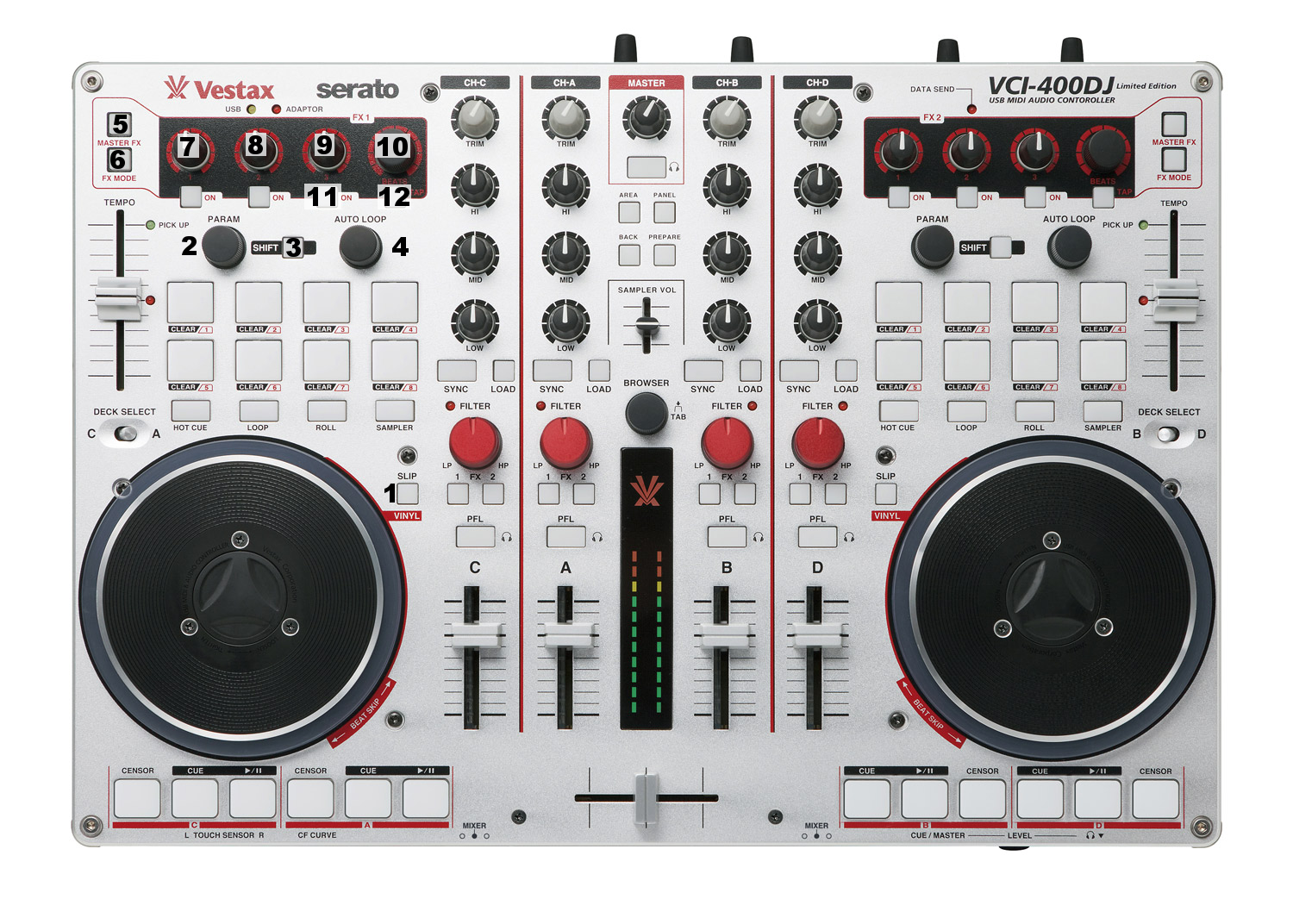Vestax VCI-400
The Vestax VCI-400 is a 4 deck controller. It has an integrated audio interface with balanced outputs (XLR and 1/4» TRS), two pairs of RCA inputs, and two XLR / 1/4» combination microphone inputs. The microphone inputs can be sent to the computer for recording and broadcasting. The RCA inputs do not have phono preamps and do not work for vinyl control. The VCI-400 requires its own power supply; it does not run on USB bus power.
This controller has been discontinued as Vestax went out of business in 2014.
New in version 1.10.1.
Compatibility
The original VCI-400 firmware has a bug that prevents the sound card from working with Linux. Now that Vestax is out of business, drivers and firmware for Vestax devices are hosted on Serato’s website. If your VCI-400’s sound card does not appear as an available device using Linux, use the firmware updater on a computer running Windows or Mac OS X. This will only need to be done once and then the controller will continue to work with Linux.
Note that the VCI-400 and VCI-400 Ean Golden Edition are incompatible. Their firmwares use different MIDI messages to communicate with the computer. Unfortunately, it is not possible to switch between the VCI-400 and VCI-400 Ean Golden Edition firmware.
Mapping

Vestax VCI-400 (top view with annotations)
The VCI-400 mapping for Mixxx is based on the Serato Limited Edition overlay.
For regular use, make sure the “mixer select” switches are all the way to the left. If you move them to the right, the Play / Cue buttons will be used to select vinyl control modes instead.
Most of the functions are exactly as they appear on the overlay, and the overlay is very nicely labeled so that’s the best place to start.
The four small buttons below the grouping of 8 buttons selects which mode the 8 buttons are in, either Hot Cues, Loops, Rolls, or Samples. Mixxx remembers which mode is selected on a per-deck basis, so when you toggle the deck-selection switches the mode may change. The button corresponding to the current mode will be lit so you know what mode you’re in.
Button Modes:
In Hot Cue mode, the 8 buttons will move Mixxx to the designated hotcue. If you hold the shift button, the hotcue will be cleared.
In Loop mode, the 8 buttons will create a new loop at the current position from size 32nd note to 16 beats.
In Roll mode, holding any of the buttons will temporarily create a loop anywhere from 32nd note to 16 beats.
In Sampler mode, both sides of the controller launch the same set of 8 samplers. Holding shift will eject a sample.
Some of the buttons have special functions in Mixxx:
The Vinyl / Slip button. While pushed, the jog wheel is in scratching mode (similar to if you push down on the platter). If you hold this button while spinning the jog wheel, you can let go of the wheel and Mixxx will still be in scratch mode. Great for backspins.
The Param knob can be used to adjust the musical key of the current track. Twist to make the tone higher or lower. If you hold the shift button (3), use this knob to scroll quickly through the track. Pushing this knob will reset the key.
Shift button
Auto Loop knob. Twisting this will change the size of the current loop, either doubling or halving the size. If you hold shift (3), twisting this knob will move the loop left or right by 1 beat per click. Pushing this knob will enable or disable looping.
The Master FX button enables the 1st FX bank to be applied to the main output.
The FX Mode button toggles which effect is in the first FX bank.
Controls FX1 Parameter 1
Controls FX1 Parameter 2
Controls FX1 Parameter 3
Controls FX1 Dry / Wet
Enable/Disable Quantize Mode.
Enable/Disable Keylock
The four small buttons in the center, Area, Panel, Back, and Prepare, don’t do anything. Neither does the sampler volume slider.
Some additional functions are accessible with the shift button:
Shift + Load to eject a track.
Shift + Play while the deck is playing does a breaking stop.
Shift + Censor does a spinback stop.
Vinyl Control Mode
If you want to use vinyl control instead of the jog wheels, you can move the mixer selection switches all the way to the right. In this mode, the Play button becomes a Vinyl Control Enable/Disable button, and the Cue button selects which Vinyl Control mode is active – Absolute, Relative, or Constant. The cue button lights up when Absolute is selected.
Note about VU Meters
There’s a bug in the way that the VCI400 firmware works – although Mixxx can control the VU meters, the VCI’s internal soundcard always also controls the VU Meters. This can result in an odd flickering effect that looks strange. For this reason, the main VU meters are disabled by default. If you’ve installed the firmware that allows decks C and D to act as pass-through mixer channels, you may see flickering there too.